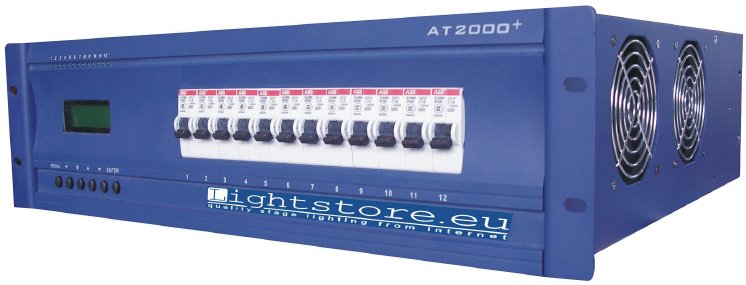The dimmer pack AT2000+ from Lightstore.eu features a number of details that are usually only available on the more expensive dimmers. For instance, any channel can be assigned an individual DMX address. There are a switching curve and four dimming curves available, one of theses curve is user-editable. Thanks to the adjustable full-on delay, the inrush current of cold lamps can be reduced – thus saving on lamp life-time. Should the DMX signal fail, the AT2000+ can either play one or a sequence of several back-up cues. 12 additional check-back LEDs provide a clear status overview – even in the dark or from a distance.
The AT2000+ is equipped with protective circuits against over-voltage and over-temperature; it also detects a neutral failure. The dimmer's rise time is 250 µs – a good compromise between EMC and weight. In idle mode, the power dissipation is below 60 W; under full load, it is less than 1%. The AT2000+ can automatically compensate frequency and voltage fluctuations using a soft control curve (thus minimising the risk of oscillation when run on a generator).
As an option, the AT2000+ can be equipped with a wireless DMX receiver (list price 78.00 GBP or 120.00 EUR); there is no need to open the housing for installation.
Including cable bushings and bending radius of the supply cable, the AT2000+ dimmer pack from Lightstore.eu is some 440 mm deep. The 19 inch unit (3 HE – approx. 132 mm) carries an IP33 rating – something open-air event companies will like to hear. The dimmer pack weights approx. 24 kg.
Even in the unlikely event of servicing, users will notice the long-term experience of the Finish manufacturer: All modules of the AT2000+ - including the output stages – can be replaced without soldering iron.
More information can e found on the Internet at www.lightstore.eu.
Triacs as well as thyristors are both semiconductor power switches that are frequently used in forward phase-control dimmers. While a thyristor only conducts current in one direction (either the positive or the negative half-wave), the triac – principally a combination of two anti-parallel thyristors – is able to conduct in both directions.
However, when it comes to extremes, the thyristor has a few advantages over the triac. The most likely situation for a lamp to blow is when it is cold – because of the high inrush-current from the dimmer. When the lamp blows, the flowing current will ionize the gas inside the bulb – and an electric arc will be the consequence. However, an electric arc is a short-circuit; the current through the semiconductor switch will then only be limited by the resistance of the connecting cables. A couple of hundred milliseconds later, the MCB will trip – but that is usually too late for a triac. A thyristor normally survives this situation because of its far higher maximum load integral (I²t) and the far better heat dissipation (by principle). In addition to that, the faster dynamic voltage slope and the better current slope considerably reduce power losses in thyristor dimmers.
When firing the two output thyristors symmetrically, there will be basically no output DC component. This is the reason why thyristor dimmer stages can be used as solid-state relays for switching complex loads like electronic power supplies.

